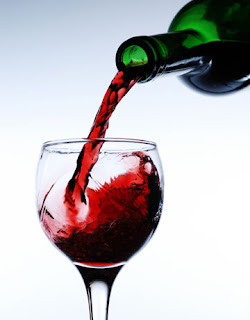The link you can find this information is: http://www.theorganicwinecompany.com/sulfites.phpWine and Sulfites: The Facts
AN ORGANIC WINE IS FIRST AND FOREMOST A WINE MADE WITH GRAPES GROWN ORGANICALLY
The public often equates organic wines with "sulfite-free" wines but this is inaccurate. Organic wines are produced using organically grown grapes. No pesticides, herbicides, fungicides, chemical fertilizers, or synthetic chemicals of any kind are allowed on the vines or in the soil. Only mined minerals, natural extracts and derivatives can be applied. Strict rules govern the winemaking process and storage conditions of all imported and domestic wines that acquire certification. Organic winemakers are not allowed to use the various chemical substances commonly found in conventional wineries to make or modify their wines. In case of emergency their toolbox is limited to a few harmless substances.SULFITES ARE A NATURAL BYPRODUCT OF FERMENTATION
Fermenting yeasts present on all grape skins generate naturally occurring sulfites in amounts ranging from 6 to 40 parts per million (ppm). Totally sulfite-free wines are therefore an accident of nature but wines low in sulfites or free of added sulfites do exist. Wines can be labelled as "Organic Wine" if no sulfites have been added and the total does not excced 10ppm in the bottle.
[According to Professor Roger Boulton, Ph.D., U.C. Davis, Department of Viticulture and Enology, even if no sulfur dioxide is added to wine, fermenting yeasts will produce SO2 from the naturally occurring inorganic sulfates in all grape juices. Thus, says Boulton, it is impossible for any wine to be completely free of sulfur dioxide.]WHAT ABOUT ADDED SULFITES?
Sulfur has been used as a preservative in winemaking for quite some time. To prevent wine spoilage, European winemakers pioneered the use of sulfur dioxide (SO2) two hundred years ago. Unfortunately, freshly pressed grape juice has a tendency to oxidize and spoil due to contamination from bacteria and wild yeasts present on the grape skins. Not only does sulfur dioxide inhibit the growth of molds and bacteria, but it also stops oxidation (browning) and preserves the wine's natural flavor.
Although technical advances permit the industry to add much less sulfur, most serious winemakers and enology professors concur that to make a consistently stable wine, some sulfites must be added to those naturally present which are not chemically active. A handful of winemakers go beyond that: They use no added sulfites at all. However, sulfite agents, when properly handled and kept to reasonable levels, are not intrinsically toxic to humans or to the environment, and many feel they are essential in order to prevent oxidation or bacterial spoilage. Therefore, American and European organic winemaking standards allow for the addition of strictly regulated amounts of SO2.
In the U.S., wines can contain up to 350ppm of sulfites. Organic winemaking standards, as adopted recently (12/00) by the USDA, limit the use of sulfites to 100ppm in all finished products. However, most organically grown wines contain less than 40ppm of sulfites. The Organic Wine Company line of wines, for instance, is regularly analyzed by the local BATF laboratory. On average the reds contain 40ppm of total sulfites (20 to 60) while the whites, along with the sparkling, contain around 70ppm (50 to 90). Some show none at all (Cartagene or certain vintages of Guy Chaumont wines). For us, this does not represent a criterion of quality in and of itself since we know that all our producers are striving to use the smallest possible amount of sulfites given their respective situation.
SULFITES IN OTHER PRODUCTS.
According to Mitchell Zeller of the Washington, D.C. based Center for Science in the Public Interest, sulfites exist in a wide variety of products at levels that are comparable to, or in excess of the concentration that is found in wine. The presence of sulfites ranging from 6 to 6000 ppm is found in products such as fruit juices, dried fruits, fruit concentrates, syrups, sugar, jams, gelatins, cake toppings, baked goods, pizza dough, frozen and dehydrated potatoes, processed vegetables, cheeses, as well as in many prescription drugs.
"CONTAINS SULFITES"
At the present time both the US and the EU regulations require that all wines, beers and spirits exceeding 10 parts per million of sulfites bear the mention "Contains Sulfites" on their label. Wines that contain less than 10 ppm sulfites are not required to do it and can state "Free of Added Sulfites" if that is the case.
WHO IS AT RISK?
The FDA says only about .4% of the population, or about a million people, is considered highly allergic to sulfites. According to Dr. Vincent Marinkovich, an allergist and clinical immunologist who has performed extensive research on SO2, sulfites pose no danger to about 99.75% of the population; the highest risk group are asthmatics (about 5% of the population) and only about 5% of this group is allergic to sulfites.
Many people, however, have simply a low tolerance for sulfites. They are considered sulfite-sensitive. Even for moderate wine drinkers, the average level of sulfites found in many commercial wines can cause heartburns or other side effects. Unpleasant reactions include burning sensations, hives, cramps, and flushing of the skin. For them, organically grown wines are an especially good choice since they contain minimal amounts of sulfites that will in most cases lie below their threshold level.
Enjoying God's creation to the fullest potential through healthy choices in food, beauty products and life.
Sulfites in Wine.
I've wondered for some time why wine, even organic, contained sulfites. Well after looking into it, I found this website that explained it in perfect detail and simplicity. I'm going to cheat and just paste the excerpt:
Subscribe to:
Post Comments (Atom)


No comments:
Post a Comment